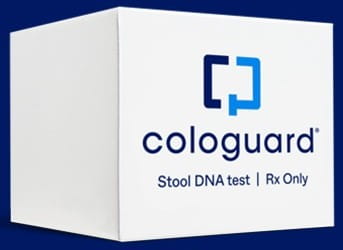Cologuard-first screening can help save more lives1,2
Outcomes of Cologuard-first and colonoscopy-first screening at different adherence levels were compared in a simulated analysis. When adherence for both methods is assumed at the same rate, the Cologuard test and colonoscopy saved a similar number of lives.1,2

Provider has been compensated for sharing their expertise and for acting as a consultant for Exact Sciences.
When adherence is adjusted to approximated real-world adherence rates in the simulated analysis, with the Cologuard test at 70% and colonoscopy at 40%1,2*:
More lives would be saved
if patients screened with the Cologuard test first

Cologuard eligibility
Discover which of your patients are eligible to benefit from the high performance and adherence of the Cologuard test.
A modeling study estimated that after 3 years, the Cologuard test could4:
- Detect ~127,000 more cases of CRC
- Produce estimated treatment cost savings of $59.3 billion
Start CRC screening with the Cologuard test to identify and prioritize patients for colonoscopy.5,6
- Analysis based on data from a review for the USPSTF to demonstrate how the benefits, burdens, and harms of CRC screening vary by screening modality. 3 microsimulation models were used to estimate life-years gained, CRC incidence and mortality, number of screening tests required, and complications of screening: CRC-SPIN, MISCAN, and SimCRC. All models were calibrated to SEER CRC incidence rates from 1975-1979 and adenoma prevalence from autopsy studies. Screening test characteristics were primarily based on a systematic USPSTF review. No formal sensitivity analysis on adherence rates was performed. Perfect adherence was assumed for a baseline. This analysis evaluated the effect of imperfect adherence on screening outcomes.1
- The goal of this study was to recalibrate, cross-model, and validate CRC-AIM against 3 CISNET models, in order to demonstrate the unbiasedness and comprehensiveness of the model. Screening-related outcomes were comparable with CISNET model predictions.3
CISNET=Cancer Intervention and Surveillance Modeling Network; CRC-AIM=Colorectal Cancer-Adenoma Incidence and Mortality; CRC-SPIN=Colorectal Cancer Simulated Population model for Incidence and Natural history; MISCAN=MIcrosimulation SCreening Analysis; SEER=Surveillance, Epidemiology, and End Results; SimCRC=Simulation Model of Colorectal Cancer; USPSTF=United States Preventive Services Task Force.
